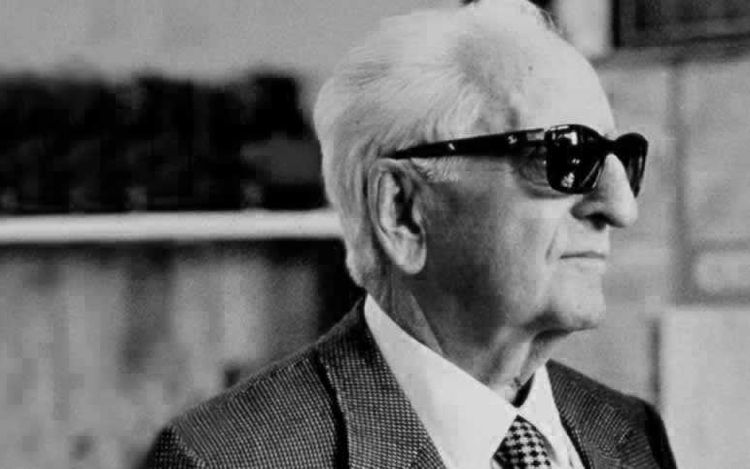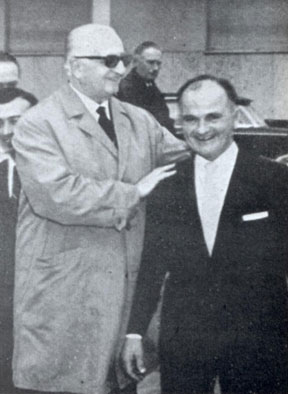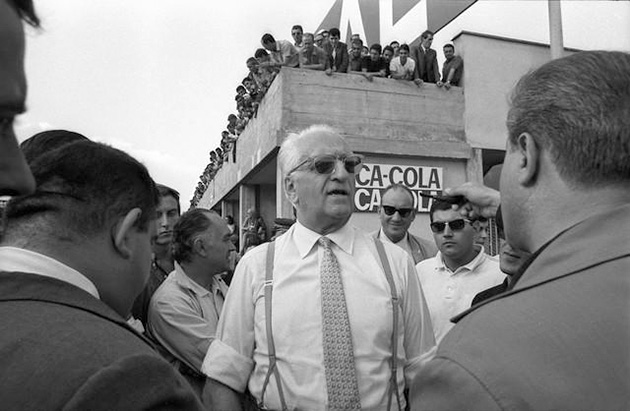<Back to Index>
- Motor Racing Driver
and Founder of the Scuderia Ferrari Enzo Anselmo Ferrari,
1898
PAGE SPONSOR
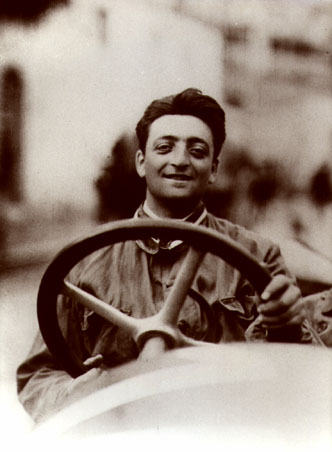
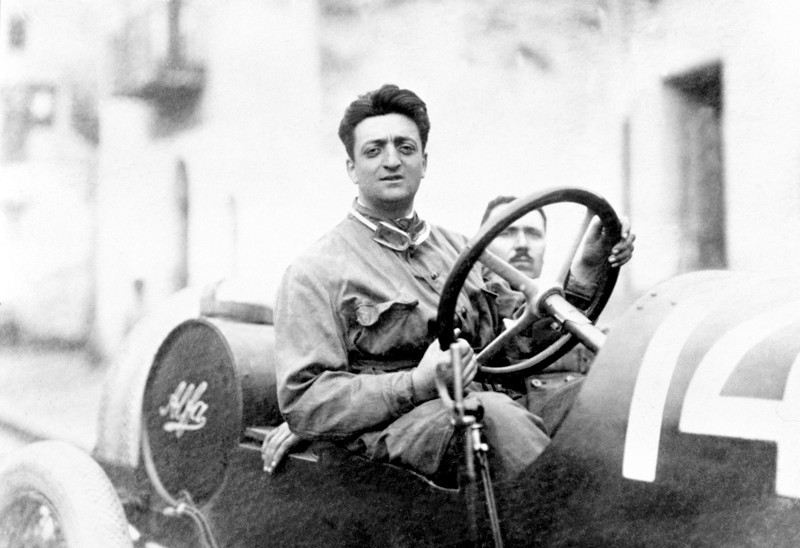
Enzo Anselmo Ferrari (February 20, 1898 – August 14, 1988) Cavaliere di Gran Croce OMRI was an Italian motor racing driver and entrepreneur, the founder of the Scuderia Ferrari Grand Prix motor racing team, and subsequently of the Ferrari automobile marque. He was often referred to as "il Commendatore".
Born in Modena, Italy, Ferrari grew up with little formal education but a strong desire to race cars. At the age of 10 and seeing 1908 Circuit di Bologna, he decided to become a driver of race cars. During World War I he was assigned to the third Alpine Artillery division of the Italian Army. His father Alfredo, as well as his older brother, also named Alfredo, died in 1916 as a result of a widespread Italian flu outbreak. Ferrari became severely ill himself in the 1918 flu pandemic and was consequently discharged from Italian service. Upon returning home he found that the family firm had collapsed.
Having no other job prospects, Ferrari eventually settled for a job at a smaller car company called CMN (Costruzioni Meccaniche Nazionali), redesigning used truck bodies into small passenger cars. He took up racing in 1919 on the CMN team, but had little initial success.
He left CMN in 1920 to work at Alfa Romeo and racing their cars in local races he had more success. In 1923, racing in Ravenna, he acquired the Prancing Horse badge which decorated the fuselage of Francesco Baracca's (Italy's leading ace of WWI) SPAD S.XIII fighter, given from his mother, taken from the wreckage of the plane after his mysterious death. This icon would have to wait until 1932 to be displayed on a racing car.
In 1924 Ferrari won the Coppa Acerbo at Pescara. His successes in local races encouraged Alfa to offer him a chance of much more prestigious competition. Ferrari turned this opportunity down and did not race again until 1927. He continued to work directly for Alfa Romeo until 1929 before starting Scuderia Ferrari as the racing team for Alfa.
Ferrari managed the development of the factory Alfa cars, and built up a team of over forty drivers, including Giuseppe Campari and Tazio Nuvolari. Ferrari himself continued racing until 1932.
The support of Alfa Romeo lasted until 1933, when financial constraints made Alfa withdraw. Only at the intervention of Pirelli did Ferrari receive any cars at all. Despite the quality of the Scuderia drivers, the company won few victories. Auto Union and Mercedes dominated the era, but Ferrari achieved a notable victory when Tazio Nuvolari beat them on their home turf at the German Grand Prix in 1935.
In 1937 Alfa took control of its racing efforts again, reducing Ferrari to Director of Sports under Alfa's engineering director. Ferrari soon left, but a contract clause restricted him from racing or designing cars for four years.
In response, Ferrari organized Auto-Avio Costruzioni, a company supplying parts to other racing teams. Ferrari did manage to manufacture two cars for the 1940 Mille Miglia, driven by Alberto Ascari and Lotario Rangoni. During World War II his firm was forced to undertake war production for Mussolini's fascist government. Following Allied bombing of the factory, Ferrari relocated from Modena to Maranello. It was not until after World War II that Ferrari could start making cars bearing his name, founding today's Ferrari S.p.A. in 1947.
The first open - wheel race was in Turin in 1948 and the first victory came later in the year in Lago di Garda. Ferrari participated in the Formula 1 World Championship since its introduction in 1950 but the first victory was not until the British Grand Prix of 1951. The first championship came in 1952 - 53, with Alberto Ascari. The company also sold production sports cars in order to finance the racing endeavors not only in Grands Prix but also in events such as the Mille Miglia and Le Mans.
Ferrari's decision to continue racing in the Mille Miglia brought the company new victories and greatly increased public recognition. However, increasing speeds, poor roads, and nonexistent crowd protection eventually spelled disaster for both the race and Ferrari. During the 1957 Mille Miglia, near the town of Guidizzolo, a 4.0 liter Ferrari 335S driven by the flamboyant Alfonso de Portago was traveling at 250 km/h when it blew a tire and crashed into the roadside crowd, killing de Portago, his co-driver, and nine spectators, including five children. In response, Enzo Ferrari and Englebert, the tire manufacturer, were charged with manslaughter in a lengthy criminal prosecution that was finally dismissed in 1961.
Many of the firm's greatest victories came at Le Mans (14 victories, including six in a row 1960 - 65) and in Formula One during the 1950s and 1960s, with the successes of Juan - Manuel Fangio (1956), Mike Hawthorn (1958), Phil Hill (1961) and John Surtees (1964).
In 1969 the problems of reduced demand and inadequate financing forced Ferrari to allow Fiat to take a stake in the company. Ferrari had previously offered Ford the opportunity to buy the firm in 1963 for US$18 million but, late in negotiations, Ferrari withdrew once he realized that he would not have been able to retain control of the company sporting program. Ferrari became joint - stock and Fiat took a small share in 1965 and then in 1969 they increased their holding to 50% of the company. (In 1988 Fiat's holding rose to 90%).
In 1974 Ferrari nominated Luca Cordero di Montezemolo sporting director. Niki Lauda won the championship in 1975 and 1977. After those successes and another title for Jody Scheckter in 1979, the company's Formula One championship hopes fell into the doldrums.
1982 opened with a strong car, the 126C2, world-class drivers, and promising results in the early races. However, Gilles Villeneuve was killed in the 126C2 in May, and teammate Didier Pironi had his career cut short in a violent end over end flip on the misty back straight at Hockenheim in August. Pironi was leading the driver's championship at the time; he would lose the lead as he sat out the remaining races. Ferrari remained chairman of the company until his death in 1988 but the team would not see championship glory again during his lifetime.
Ferrari's management style was autocratic and he was known to pit driver against driver in the hope of improving performance. Following the death of Alberto Ascari, with whom he had a strong relationship, he chose not to get too close to his drivers.
Some critics believe that Ferrari deliberately increased psychological pressure on his drivers, encouraging intra - team rivalries and fostering an atmosphere of intense competition for the position of number one driver. “He thought that psychological pressure would produce better results for the drivers,” said Ferrari team driver Tony Brooks. "He would expect a driver to go beyond reasonable limits... You can drive to the maximum of your ability, but once you start psyching yourself up to do things that you don’t feel are within your ability it gets stupid. There was enough danger at that time without going over the limit.”
During the late 1950s and 1960s seven Ferrari drivers - Alberto Ascari, Eugenio Castellotti, Alfonso de Portago, Luigi Musso, Peter Collins, Wolfgang Von Trips, and Lorenzo Bandini - were all killed driving Ferrari racecars. Although such high death toll was not at all unusual in motor racing in those days, the Vatican newspaper L’Osservatore Romano described Ferrari as being like the god Saturn, who consumed his own sons. In Ferrari's defense, contemporary F1 race car driver Stirling Moss commented: “I can’t think of a single occasion where a (Ferrari) driver’s life was taken because of mechanical failure.”
In public Ferrari was careful to acknowledge the drivers who risked their life for his team, insisting that praise should be shared equally between car and driver for any race won. However, his longtime friend and company accountant, Carlo Benzi, related that privately Ferrari "would say that the car was the reason for any success.”
Enzo Ferrari spent a reserved life, and rarely granted interviews. He was married to Laura Dominica Garello Ferrari (c. 1900 - 1978) from 1932 until her death. They had one son, Alfredo "Dino", who was born in 1932 and groomed as Enzo's successor, but he suffered from ill health and died from muscular dystrophy in 1956. Enzo had a second son, Piero, with his mistress Lina Lardi in 1945. As divorce was illegal in Italy until 1975, Piero could only be recognized as Enzo's son after Laura's death in 1978, and later becam a vice president of the Ferrari company with a 10% share ownership.
Made a Cavaliere del Lavoro in 1952, to add to his honors of Cavaliere and Commendatore in the 1920s, Ferrari also received a number of honorary degrees, the Hammarskjöld Prize in 1962, the Columbus Prize in 1965, and the De Gasperi Award in 1987. In 1994, he was posthumously inducted into the International Motorsports Hall of Fame.
Enzo Ferrari died on August 14, 1988 in Maranello at the age of 90. His death was not made public until two days later, as by Enzo's request, to compensate for the late registration of his birth. He witnessed the launch of the Ferrari F40, one of the greatest road cars at that time, shortly before his death, which was dedicated as a symbol of his achievements. In 2003 the first car to be named after him was launched as the Enzo Ferrari.
The Italian Grand Prix was held just weeks after Ferrari's death, and, fittingly, the result was a 1-2 finish for Ferrari, with Gerhard Berger leading home Michele Alboreto; it was the only race that McLaren did not win that season. After Ferrari's death, the Scuderia Ferrari team has had further success, winning the World Drivers' Championship in 2000, 2001, 2002, 2003 and 2004 with Michael Schumacher and in 2007 with Kimi Räikkönen.
